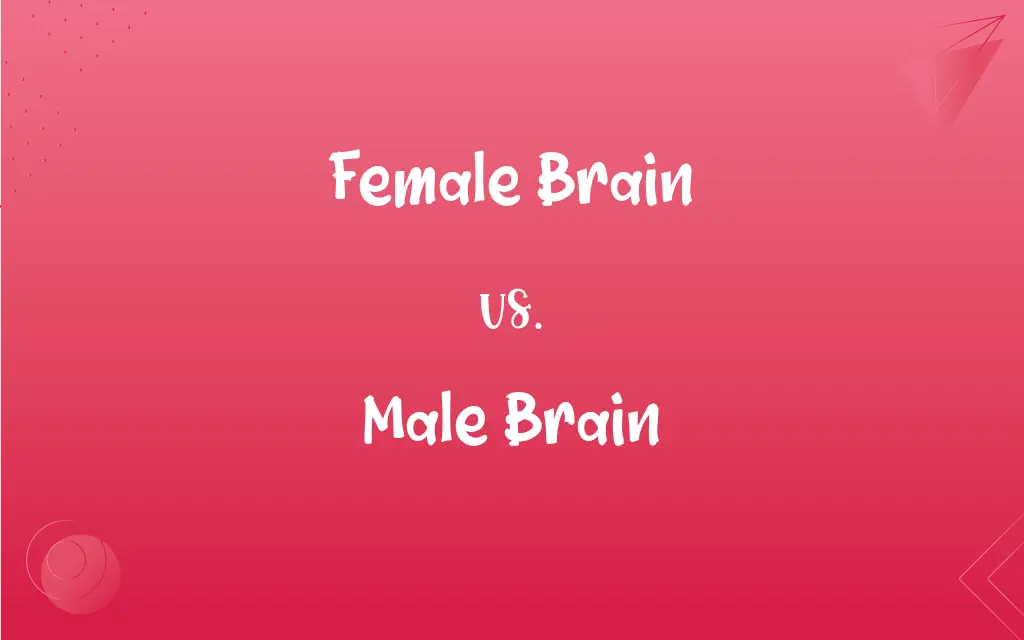Female Brain vs. Male Brain: What's the Difference?
Edited by Aimie Carlson || By Harlon Moss || Updated on October 28, 2023
The female brain and male brain refer to the brains of females and males respectively, with some differences in structure and function, but much individual variability.

Key Differences
The female brain and male brain are the central processing organs in females and males respectively. Both play crucial roles in cognition, emotion, and regulating bodily functions. However, they exhibit some differences, often influenced by a combination of genetics, hormones, and environmental factors.
The female brain tends to mature faster than the male brain during adolescence. Research has shown that certain areas related to language and fine motor skills might develop sooner in females. On the other hand, the male brain might exhibit a more prolonged developmental trajectory, with some areas maturing later than in females.
Connectivity within the female brain and male brain also shows some distinctions. Some studies suggest that females might have stronger connections side-to-side (between the left and right hemispheres), which could be associated with analytical and intuitive thinking. The male brain, in contrast, might exhibit stronger connections from front to back, potentially linked with perception and motor functions.
Size-wise, the male brain is typically larger in volume than the female brain. However, size does not necessarily equate to cognitive ability or intelligence. Both brains are highly adaptable and capable of a wide range of functions and skills.
It's essential to understand that while there are some differences between the female brain and male brain, there's significant overlap. Individual capabilities, talents, and intelligence are not strictly determined by gender, and there's a vast spectrum of abilities within both genders.
ADVERTISEMENT
Comparison Chart
Development
Tends to mature faster during adolescence
Has a more prolonged developmental trajectory
Connectivity
Stronger side-to-side connections
Stronger front-to-back connections
Size
Typically smaller in volume
Typically larger in volume
Hormonal Influence
Influenced by estrogen and progesterone cycles
Influenced by testosterone levels
Cognitive Differences
Might excel in language and fine motor skills earlier
Might show strengths in spatial tasks earlier
ADVERTISEMENT
Female Brain and Male Brain Definitions
Female Brain
The female brain possesses strong side-to-side connections, possibly influencing analytical and intuitive tasks.
Studies suggest the female brain's connectivity might aid in tasks requiring both hemispheres.
Male Brain
Influenced by testosterone, the male brain has its unique hormonal interactions and effects.
The presence of testosterone can have specific effects on the male brain's structure and function.
Female Brain
The female brain, while typically smaller in volume than the male brain, is equally complex and capable.
Despite its size difference, the female brain exhibits immense adaptability and function.
Male Brain
The male brain, while typically larger in volume, doesn't directly correlate size with intelligence or capability.
Even with its larger size, the male brain's cognitive abilities vary widely among individuals.
Female Brain
The female brain is subject to hormonal fluctuations that can influence cognition and mood.
The menstrual cycle can impact the neurochemistry of the female brain.
Male Brain
The male brain pertains to the brain of a male individual, shaped by genetic and hormonal influences.
The male brain undergoes significant changes during puberty due to testosterone.
Female Brain
The female brain refers to the brain of a female individual, influenced by genetic and hormonal factors.
The female brain might show certain neural pathways related to multitasking.
Male Brain
The male brain might show stronger front-to-back connections, linked to perception and motor functions.
This connectivity in the male brain could influence spatial reasoning tasks.
Female Brain
The female brain has been studied for its unique development patterns during adolescence.
Research has delved into how the female brain matures during teenage years.
Male Brain
The male brain's development can exhibit a more extended trajectory, especially during adolescent years.
Certain areas in the male brain might mature a bit later than in their female counterparts.
FAQs
How does the male brain differ from the female brain?
While both have many similarities, they differ in aspects like development, connectivity, size, hormonal influences, and some cognitive functions.
Is the male brain larger than the female brain?
Typically, the male brain is larger in volume, but size doesn't equate to cognitive ability or intelligence.
Can the brains of transgender individuals provide insights into gender brain differences?
Transgender brain studies offer insights into the interplay of biology and identity, highlighting the complexity of gender and brain structures.
How does connectivity differ between the female brain and male brain?
Some studies suggest females have stronger side-to-side connections, while males might have stronger front-to-back connections.
How do age and life experiences shape the female brain and male brain differently?
Both brains undergo changes due to age, experiences, and learning, but how they're affected can be influenced by hormonal cycles and gender-specific experiences.
Do the female brain and male brain respond differently to stress?
There may be some differences in stress response, influenced by hormones and neural pathways, but individual reactions can vary widely.
Do these brain differences influence learning styles?
Some studies suggest potential influences on learning styles, but individual preferences and abilities play a significant role.
How do the female brain and male brain process emotions?
Both process emotions intricately, but hormonal and neural differences might lead to varied emotional expressions and experiences.
Are there cognitive tasks where the female brain typically outperforms the male brain or vice versa?
While there might be gender averages for certain tasks, individual performance varies widely, and no gender inherently excels in all cognitive tasks.
Do these brain differences lead to intelligence differences?
No, intelligence varies widely among individuals and is not determined solely by gender or brain size.
Are there tasks or skills inherently better for one gender due to brain differences?
While there might be tendencies or averages, individual capabilities vary widely, and no task is inherently better for one gender.
Can the female brain and male brain be visually differentiated in medical imaging?
While there are average differences, individual variations make it challenging to determine gender solely from brain imaging.
What is the female brain?
The female brain refers to the brain of a female individual, influenced by genetics, hormones, and environmental factors.
How do hormones impact the female brain and male brain?
The female brain is influenced by estrogen and progesterone cycles, while the male brain is influenced by testosterone levels.
Does brain size correlate with memory capability?
Brain size doesn't directly correlate with memory capability; factors like neural connections and brain health play more significant roles.
Are there gender differences in brain areas related to empathy or communication?
Some studies suggest potential differences, but individual variability and environmental factors also influence these skills.
Is it accurate to label behaviors as stemming from a "female brain" or "male brain"?
While there are gender-related tendencies, labeling behaviors as strictly male or female oversimplifies the complexity of individual brains and behaviors.
Do both brains mature at the same rate?
The female brain tends to mature faster during adolescence, while the male brain may have a more prolonged developmental trajectory.
How do environmental factors affect the female brain and male brain?
Both brains are influenced by upbringing, experiences, education, and social factors which can shape neural pathways and behaviors.
Is the concept of a "gendered brain" universally accepted in science?
While there are observed differences, the concept of strictly "gendered" brains is debated, as there's significant overlap and individual variability.
About Author
Written by
Harlon MossHarlon is a seasoned quality moderator and accomplished content writer for Difference Wiki. An alumnus of the prestigious University of California, he earned his degree in Computer Science. Leveraging his academic background, Harlon brings a meticulous and informed perspective to his work, ensuring content accuracy and excellence.
Edited by
Aimie CarlsonAimie Carlson, holding a master's degree in English literature, is a fervent English language enthusiast. She lends her writing talents to Difference Wiki, a prominent website that specializes in comparisons, offering readers insightful analyses that both captivate and inform.































































